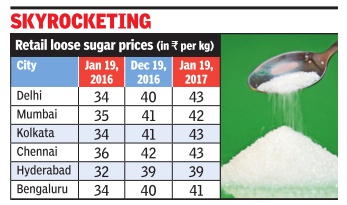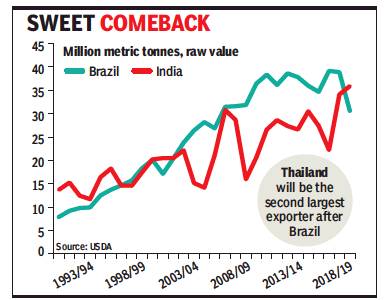Sugar, sugarcane: India
This is a collection of articles archived for the excellence of their content. |
Contents |
Cultivation
2013- 2016: decline in Karnataka
H.S. NARASIMHA KUMAR, Sugarcane cultivation sees major decline, March 14, 2017: The Hindu
Growers discouraged by government’s failure to get them remunerative prices
The Karnataka State Sugarcane Growers’ Association has said that there has been a substantial decline in sugarcane cultivation in Karnataka. It noted that in 2013, sugarcane was grown across 9.5 lakh hectares, while in 2016, it was grown across just three lakh hectares in the State.
If the government failed to encourage cane growers by giving them interest free loans and through scientific pricing, they would stop cultivating the crop and sugar factories may have to be shut, it stated.
Kuruburu Shanthkumar, president of the association, told reporters here on Monday that even the number of farmers cultivating sugarcane had reduced considerably in the State. He said that cane growers were discouraged by the failure of the government to get them remunerative prices. The government would get a tax of Rs. 3,000 per tonne sugarcane and the sudden fall in production had resulted in heavy losses to the State exchequer, he said.
The FRP (Fair and Remunerative price) which was fixed at Rs. 2,200 per tonne in 2014-15 has not been enhanced for three years though prices of sugar had touched Rs. 50 per kg, Mr. Shanthkumar said adding that farmers were incurring couple of hundred rupees losses for each tonne of cane that they had grown instead of earning the same in profits.
The association has urged the Union government to implement the recommendation of the M.S. Swaminathan committee forthwith. He urged the State government to give crop loss compensation of Rs. 25, 000 per acre to farmers who have incurred crop loss owing to drought in the State in the past two years.
Mr. Shanthkumar also urged the government to waive off all farm loans to prevent farmers resorting to drastic measures. He said that it was high time the government realised that the farmers were made to incur losses in the absence of a system to get remunerative prices for agriculture produce.
Why farmers stick to cane despite due/ 2019
Mills Owe ₹8,200cr To Farmers In UP Alone But Peasants Not Likely To Switch To Other Crops
Unrest simmers in districts of western Maharashtra and parts of UP, the sugar bowls of India, over unpaid cane dues. But despite the problems which beset farmers, they have continued to cultivate a crop that means more to them than just livelihood.
Anger among farmers in Maharashtra spilled out into the streets on January 12. A mob gathered outside Kranti Sugar Factory in Sangli and Krishna Sugar Factory in Satara and set the office gates on fire. Four other factories were ransacked. There were fresh protests on Monday too.
Farmers in western Maharashtra have cultivated sugarcane for decades, thanks to the fertile land, ample water and “assured money”. The government announces a fair and remunerative price (FRP) every year that mills must pay farmers after purchasing cane. The mills have, however, struggled to do so for many years. This crushing season alone, since October 2018, mills owed Rs 4,576 crore to farmers till December 9.
The violence came hours after farmers got to know that private and cooperative sugar factories had unilaterally deposited 80% of the payment in their bank accounts --Rs 2,300 per tonne when the FRP is Rs 2800 per tonne.
Pradip Godase, a farmer in Sangli, said, “It’s true we have to fight for FRP every year, but sugarcane is the only crop that usually gives us assured returns. It also provides fodder and cattle-rearing becomes our second occupation.” They also spend less on pesticides and fertilisers compared to other crops.
This loyalty to the crop can also be seen in UP. A staggering Rs 8,200 crore in dues was to be paid by mills to farmers by the end of 2018. A glut in sugar production meant prices dropping below the breakeven mark for mill owners. One would assume that with payments stuck, they would switch to another crop.
There’s no chance of that happening anytime soon. For farmers, especially in western UP districts of Baghpat, Bijnor, Muzzafarnagar, Shamli, Bulandshahr and Meerut, being identified as a cane cultivator is a matter of pride that cannot be compromised. “We have more respect than someone who grows vegetables, which needs less land but greater amount of manual labour,” says Bijnor farmer Virender Singh.
In September 2018, UP CM Yogi Adityanath advised farmers to “grow other crops as too much sugar leads to diabetes”. It’s an advice farmers in the area take with a pinch of salt. “Sugarcane is the crop of our forefathers and we are carrying forward the legacy. Why would we grow anything else?” said Virender.
It is this persistence that has seen the area under cane cultivation in UP increase from 22.9 lakh hectare in 2017 to 26.7 lakh hectare in 2018.
Ashok Kumar, director (research) at Meerut’s Sardar Vallabh Bhai Patel Agriculture University, said, “Pride about cane cultivation is visible among those with large land holdings, who can absorb delays in payment. Many are confident they will get paid sooner or later.”
Naveen Pradhan, a Meerut farmer, added, “Besides, the crop needs very little maintenance, is robust and can survive inclement weather. In worst-case scenarios, the loss is never more than 10%. In wheat, there might be a 30% to 40% loss sometimes.”
Prices
2016> 2017

See graphic:
Retail sugar prices in Jan 2016 and Jan 2017
Production
1993-2018

From: Dipak Dash, India set to beat Brazil in sugar output after 15 yrs, November 22, 2018: The Times of India
India is set to push Brazil to second position in sugar production during 2018-19 after 15 years. India’s sweetener production is estimated to touch 35.9 million tonnes (MTs), registering an increase of about 5.2% over last year, according to the latest report of the US Department of Agriculture (USDA).
The report by USDA’s Foreign Agricultural Service wing released on Tuesday has estimated Brazil’s sugar production to dip by 8.3 MTs and bringing its total production to 30.6 MTs during this sugar year.
It says the 21% drop in sugar manufacturing is primarily “due to lower sugarcane yields and more sugarcane being diverted towards ethanol production as record global sugar supplies have led to weak prices”.
The global production of the sweetener is also estimated to tumble to nearly 185.9 MTs, which is about nine million tonnes less than last year, mainly attributed to Brazil cutting down its sugar manufacturing.
Attributing that the higher area and yields in India would boost the production of sugar in the country , the report said consumption is also forecast at a record 27.5 MTs due to a growing population and strong demand from food processors.